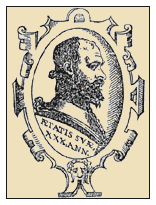Masters of the Verdadera Destreza
Introduction | Jerónimo Sánchez de Carranza | Luis Pacheco de Narváez
Jerónimo Sánchez de Carranza
Biographical Information | Publication Date
According to the scholar Stefano de Merich, there is a common misconception among scholars, libraries and even vendors about the publication date of Carranza's primary work, Libro de Hieronimo de Caranca, natvral de Sevilla, que trata de la philosophia de las armas y de su destreza y de la aggression y defension christiana (1582). This confusion has led to it being listed with one of two publication dates, 1569 or 1582, and it has caused some to speculate whether there is a difference between the two "supposed" editions. There is substantial evidence that while the book was completed in 1569, as is commented in the text, it was not published until 1582. Thus, 1582 is the correct (and only) publication date.
Stefano de Merich provided the following evidence for this conclusion (July 6, 2003):
In the colophon (f. 280 verso) we read:
"Acabosse este libro de
la Speculacion de la Destreza Año de 1569. Imprimiosse en la Ciudad de
Sanlucar de Barrameda en Casa del mesmo Autor por mandado del Excelentissimo Señor
Don Alonso Perez de Guzman el Bueno Duque de Medina Sidonia Cauallero de la Insigne
Orden del Tuson. Año de 1582".
These lines can be translated as follows:
"This Libro de la speculacion de la destreza was completed in the
year 1569. It was printed in the city of Sanlucar de Barrameda in its
author's printing-house, by order of His Excellency the Lord Don Alonso
Pérez de Guzman The Good, Duke of Medina Sidonia, Knight of the
Famous Order of the Golden Fleece. Year of 1582."
Merich's opinion: I think the author wanted to underline the difference
between the two dates, the former being related to the "writing"
of the work, the latter to its printing / publication. Moreover I wrote
about the matter to the Biblioteca Nacional of Madrid: they sent me
the colophon, which is the same in all the copies, and the Library does
not own copies printed in 1569 (or manuscripts).
So I think I am able to state that the correct date of publication of
the Libro de la Philosophia de las Armas is 1582 and that no
copies were printed in 1569: in the Licencia (dated Lisbon, April, the
1st, 1582) King Philip II of Spain and Portugal underlined that Carranza
was not able to print the book before 1582, engaged as he was in his
university studies ("[...] por auer estado ocupado en vuestros
estudios, no aueys podido imprimir el dicho libro").
Moreover, in Don Enrique de Leguina's Bibliografía e historia
de la esgrima española (Madrid, 1904), it states that: "[...]
Pacheco de Narváez, que tan concienzudo estudio hizo del sistema
de Carranza, dice, terminantemente, que aun cuando escribió la
obra en 1569, no salió a luz hasta 1582" (Translation: "Pacheco
de Narváez, who so deeply studied Carranza's system, states,
in final way, that in spite of that the work was written in 1569, it
was not printed until 1582").
Last, in the verses of a long poem
Carranza himself makes allusions to the fact that he was going to publish his
book in 1569, but something (or someone: the point is not clear) prevented him
from doing it.
I also believe that the two texts (1569 and 1582) are the same, since the only historical allusions Carranza makes are facts which took place in 1569. In 1582 he printed (and not re-printed) the 1569-text.
Information about the Contributer:
Stefano de Merich is a scholar from Rome, Italy, and he
dedicated his 407 page dissertation, Armi, lettere e onore nel
Libro [...] qve trata de la Philosophia de las Armas [...] di Jerónimo
de Carranza (1582) (30/04/2003, italian), to Carranza's main work.
He wrote a commentary to the fencing treatise, focusing above all
on the fact it is a XVI century dialogue. He also underlined the importance
of Carranza in the Spanish literature of the "Siglo de Oro"
and his contribution to the works of Cervantes, Lope de Vega, Quevedo,
and the development of the picaresque novel. According to Merich,
in Carranza's mind the literary importance of his book (whose models
were Cicero, Luciano and Baldassarre Castiglione among others) was
strictly connected to the primacy of the sword-fighting technique
he invented, based on geometry, music and philosophy. In the first
chapters of his thesis, he deals with the question of the dual printing
date of the dialogue-treatise.
